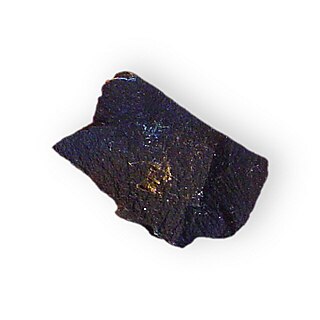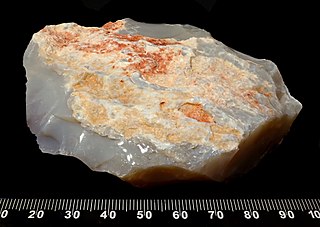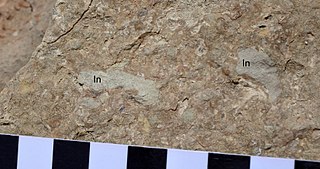Related Research Articles
A mineraloid is a naturally occurring mineral-like substance that does not demonstrate crystallinity. Mineraloids possess chemical compositions that vary beyond the generally accepted ranges for specific minerals. For example, obsidian is an amorphous glass and not a crystal. Jet is derived from decaying wood under extreme pressure. Opal is another mineraloid because of its non-crystalline nature. Pearl is considered a mineraloid because the included calcite and/or aragonite crystals are bonded by an organic material, and there is no definite proportion of the components.

Menilite is a greyish-brown form of the mineraloid opal. It is also known as liver opal or leberopal (German), due to its color. It is called menilite because it was first described from Ménilmontant (Paris), France, where it occurs as concretions within bituminous Early Oligocene Menilite Shales.

Opal is a hydrated amorphous form of silica (SiO2·nH2O); its water content may range from 3 to 21% by weight, but is usually between 6 and 10%. Due to its amorphous property, it is classified as a mineraloid, unlike crystalline forms of silica, which are considered minerals. It is deposited at a relatively low temperature and may occur in the fissures of almost any kind of rock, being most commonly found with limonite, sandstone, rhyolite, marl, and basalt.

Chert is a hard, fine-grained sedimentary rock composed of microcrystalline or cryptocrystalline quartz, the mineral form of silicon dioxide (SiO2). Chert is characteristically of biological origin, but may also occur inorganically as a chemical precipitate or a diagenetic replacement, as in petrified wood.

Psilomelane is a group name for hard black manganese oxides including hollandite and romanechite. Psilomelane consists of hydrous manganese oxide with variable amounts of barium and potassium. Psilomelane is erroneously, and uncommonly, known as black hematite, despite not being related to true hematite, which is an iron oxide.

Geyserite, or siliceous sinter, is a form of opaline silica that is often found as crusts or layers around hot springs and geysers. Botryoidal geyserite is known as fiorite. Geyserite is porous due to the silica enclosing many small cavities. Siliceous sinter should not be confused with calcareous sinter, which is made of calcium carbonate.

Chrysocolla ( KRIS-ə-KOL-ə) is a hydrous copper phyllosilicate mineral and mineraloid with the formula Cu
2 – xAl
x(H
2Si
2O
5)(OH)
4⋅nH
2O (x < 1) or (Cu, Al)
2H
2Si
2O
5(OH)
4⋅nH
2O).

Lechatelierite is silica glass, amorphous SiO2, non-crystalline mineraloid. It is named for Henry Louis Le Chatelier.

Ozokerite or ozocerite, archaically referred to as earthwax or earth wax, is a naturally occurring odoriferous mineral wax or paraffin found in many localities. Lacking a definite composition and crystalline structure, it is not considered a mineral but only a mineraloid. The name was coined from Greek elements Όζω ozο, to stink, and κηρός keros, wax.

A botryoidal texture or mineral habit, is one in which the mineral has an external form composed of many rounded segments, named for the Ancient Greek βότρυς (bótrus), meaning "a bunch of grapes". This is a common form for many minerals, particularly hematite and malachite, which are known for frequently forming botryoidal masses. It is also a common form of goethite, smithsonite, fluorite, and chrysocolla.

Hyalite is a transparent form of opal with a glassy lustre. It may exhibit an internal play of colors if natural inclusions are present. It is also called Muller's glass, water opal, and jalite. Müller's glass is named after its discoverer, Franz-Joseph Müller von Reichenstein.

Opalescence or play of color is the optical phenomenon displayed by the mineraloid gemstone opal, a hydrated silicon dioxide. However, each of the three notable types of opal – precious, common, and fire – display different optical effects; therefore, the intended meaning varies depending on context.

Allophane is an amorphous to poorly crystalline hydrous aluminium silicate clay mineraloid. Its chemical formula is Al2O3·(SiO2)1.3-2·(2.5-3)H2O. Since it has short-range atomic order, it is a mineraloid, rather than a mineral, and can be identified by its distinctive infrared spectrum and its X-ray diffraction pattern. It was first described in 1816 in Gräfenthal, Thuringia, Germany. Allophane is a weathering or hydrothermal alteration product of volcanic glass and feldspars and sometimes has a composition similar to kaolinite but generally has a molar ratio of Al:Si = 2. It typically forms under mildly acidic to neutral pH (5–7). Its structure has been debated, but it is similar to clay minerals and is composed of curved alumina octahedral and silica tetrahedral layers. Transmission electron micrographs show that it is generally made up of aggregates of hollow spherules ~3–5 nm in diameter. Allophane can alter to form halloysite under resilicating aqueous conditions and can alter to form gibbsite under desilicating conditions. A copper-containing variety cupro-allophane has been reported.

Botryoidal Spring is a fountain-type geyser in the Lower Geyser Basin of Yellowstone National Park in the United States.

Hyaloclastite is a volcanoclastic accumulation or breccia consisting of glass fragments (clasts) formed by quench fragmentation of lava flow surfaces during submarine or subglacial extrusion. It occurs as thin margins on the lava flow surfaces and between pillow lavas as well as in thicker deposits, more commonly associated with explosive, volatile-rich eruptions as well as steeper topography. Hyaloclastites form during volcanic eruptions under water, under ice or where subaerial flows reach the sea or other bodies of water. It commonly has the appearance of angular flat fragments sized between a millimeter to few centimeters. The fragmentation occurs by the force of the volcanic explosion, or by thermal shock and spallation during rapid cooling.

The Opal Creek Wilderness is a wilderness area located in the Willamette National Forest in the U.S. state of Oregon, on the border of the Mount Hood National Forest. It has the largest uncut watershed in Oregon.
In the field of mineralogy, fracture is the texture and shape of a rock's surface formed when a mineral is fractured. Minerals often have a highly distinctive fracture, making it a principal feature used in their identification.

In geology, intraclasts are irregularly-shaped grains that form by syndepositional erosion of partially-lithified sediment. Gravel grade material is generally composed of whole disarticulated or broken skeletal fragments together with sand grade material of whole, disaggregated and broken skeletal debris. Such sediments can contain fragments of early cemented limestones of local origin which are known as intraclasts.
Mineral alteration refers to the various natural processes that alter a mineral's chemical composition or crystallography.

Weewarrasaurus is a genus of ornithopod dinosaur from the Late Cretaceous of the Griman Creek Formation near Lightning Ridge, in New South Wales, Australia. The type and only species is W. pobeni, known from the holotype, an isolated dentary preserved in opal, as well as a secondary referred dentary. It is thought to have co-existed with multiple other ornithopods of different sizes and lineages.
References
- ↑ Manutchehr-Danai, Mohsen (2000). Dictionary of Gems and Gemology. Springer-Verlag. p. 182. ISBN 978-3540674825.